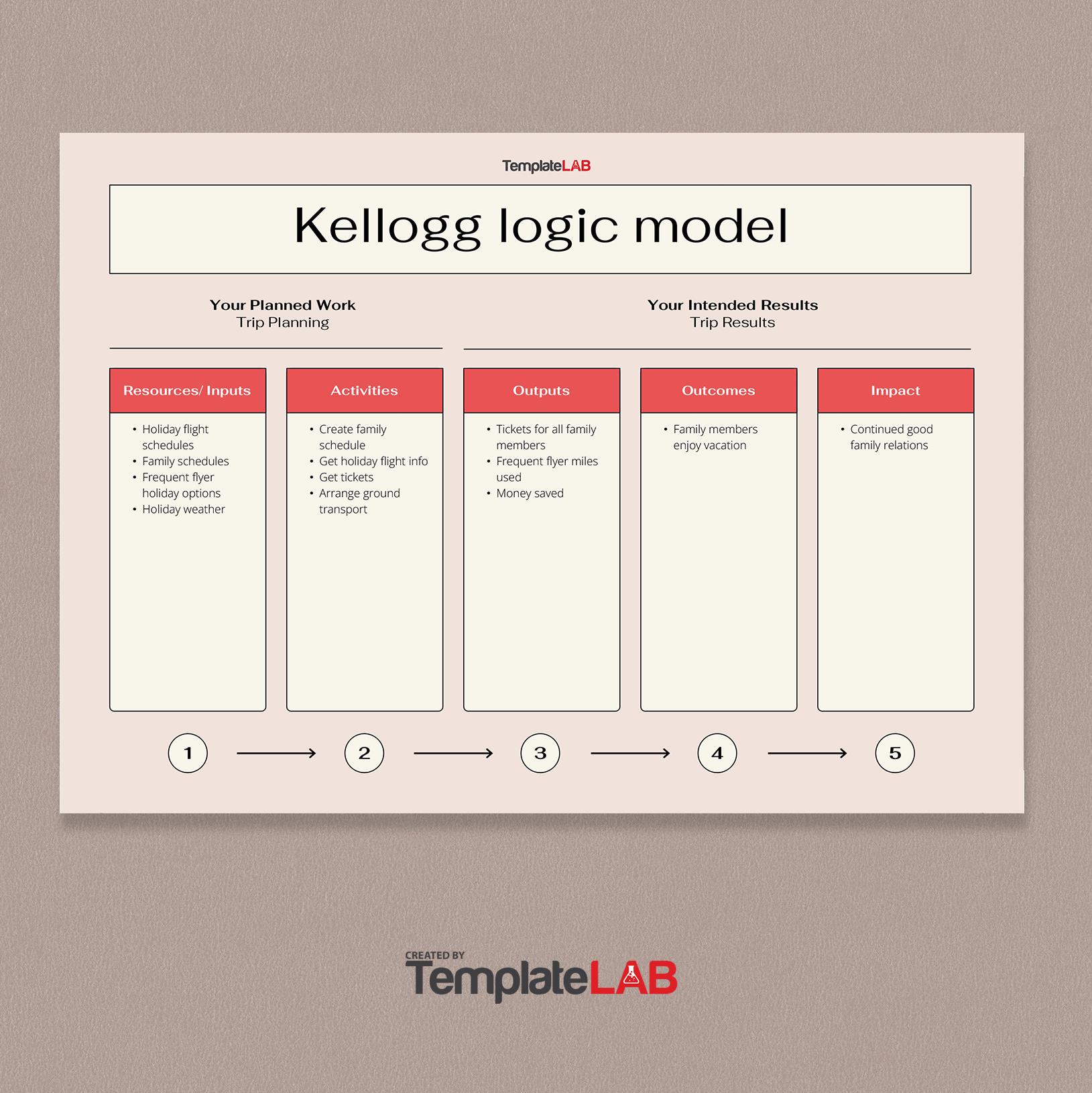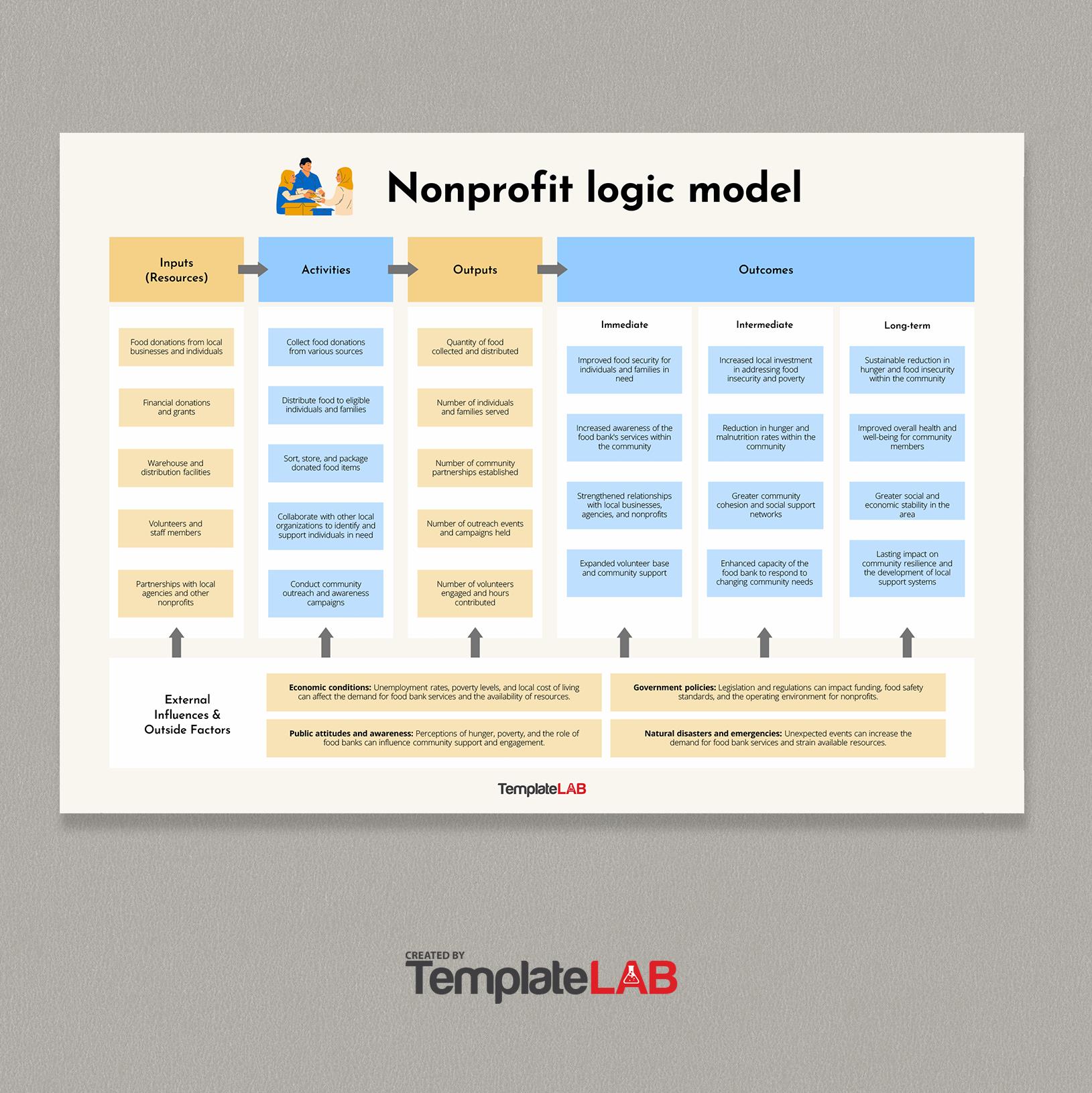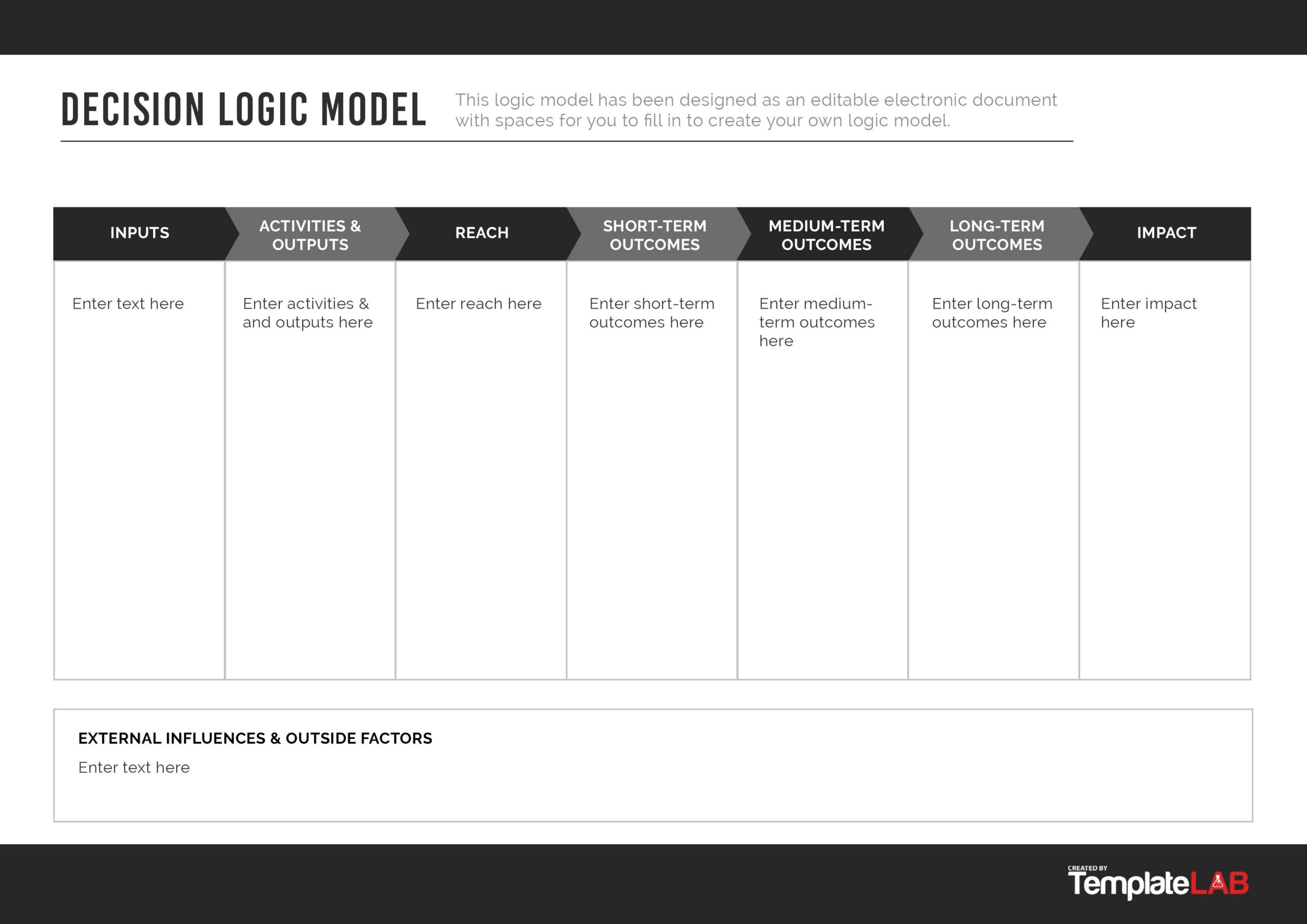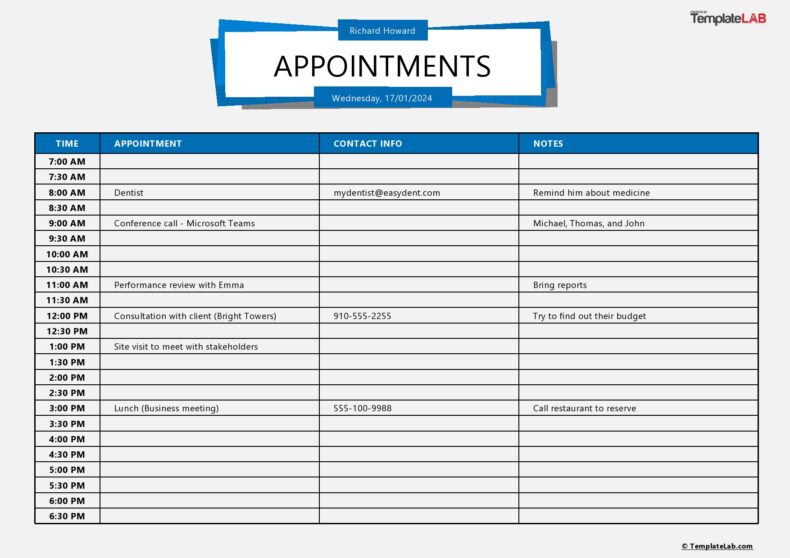When managing or planning a program, researchers are often inundated with tools to use to help maximize their planning and evaluation process.
Logic models are evaluation tools used for program planning and reporting, and are used to display the inputs, outputs, and outcomes to explain the program design. They are an effective way to highlight the cause and effect of particular outcomes and can be used to present this information to colleagues or potential stakeholders.
Table of Contents
Logic models are an excellent way to demonstrate a program’s mechanics and can help to improve upon assumed issues within a program or company. They can help potential stakeholders to consider investing in a program, as logic models clearly chart the course of a particular idea or theory.
You can use a logic model template to help you prepare your logic model and accurately present your evaluation of a program’s methods. We offer printable logic model templates for you to download and customize as necessary.
Logic Model Templates
What is a logic model?
A logic model is an evaluation tool used to display the logical relationships between resources, activities, outputs, audiences, and outcomes of a particular program.
Logic models follow a clear sequence of cause-and-effect relationships between different elements of a program, which allows users to consider an evaluation and justify the thinking behind their program design and explore how the desired results will be produced.
Logic models are typically used by program managers, researchers, and evaluators to help explain how effective their program is. This type of diagram is useful when explaining the design of a program to potential stakeholders and investors. Logic models are essentially used for evaluation, to highlight the success of a potential or existing program plan.
Using a logic model template provides a clear structure for inserting data into the logic model, meaning you can easily present your ideas and an evaluation of the program without missing any essential information.
What are the components of a logic model template?
Before creating a logic model, it is essential that you understand the key components of a logic model for evaluation purposes. Each part of the logic model will represent a different aspect of the program design, so you should familiarize yourself with these ideas before completing your logic model or filling in the logic model template. These components will help all the team members involved in the program to develop an overall evaluation of the program’s success.
- Resources or Inputs. Resources, often known as inputs, are the materials needed to create the program and implement its activities. These resources should help you to achieve the intended outcomes.
Resources can include material items and infrastructure, such as facilities, funding, or physical objects. They can also include non-material items, such as particular specialized knowledge, skills, or support from participants or the community. - Activities. Activities are the processes and events to help the program achieved the desired outcomes. They are essentially a part of the logic model template that represents the implementation the program. Examples of activities can include developing the curriculum material, improving training, analyzing student or employee data, or collaborating with other organizations.
This section of the logic model should arguably be the most detailed section, as it will contain the main ideas for implementation of the program itself, providing realistic and suitable processes necessary to make changes or create the program. - Outputs. Outputs represent the results of your resources and activities. The output section of the logic model template will include tangible results, generally expressed through an evaluation of numbers or statistics, such as the number of employees able to perform a specific skill, the number of books read, or the number of employees trained that year.
It is important to note that although outputs are essential to understanding the overall implementation of the proposed program or change, they do not accurately assess how effective specific resources or activities are. This is instead highlighted in the ‘Outcomes’ section, which will help you in developing a more accurate evaluation of the programs. - Short-term Outcomes. Short-term outcomes evaluate a change in the program participant, linked to the output results, whether that is through increased knowledge or improved behavior.
An evaluation of the short-term outcomes can display quick changes based on the program or program changes. These outcomes can be observed immediately after the changes within the program, and are important to consider. - Long-term Outcomes. The long-term outcomes are an evaluation of the lasting impact of a program or program’s changes. These can represent changes in participants’ behavior or knowledge but from a long-term perspective. For example, in education, the long-term outcomes could be increased college acceptance rates or improved standardized test scores over a long period.
Logic Model Examples
How do you create a logic model for program evaluation?
A logic model template visually displays a link between all of the key components, making it easy for those presenting their logic models to explain their reasoning behind specific choices.
There are several different ways to create a logic model for evaluation, and you can download a logic model template to save you time and effort when creating this style of diagram.
- Identify the Problem and Set Context. You should consider why you are developing a logic model, and what is driving you to make changes to an existing program, or to make a new plan for your organization. Or, perhaps your logic model is for solely for evaluation purposes. It is essential to define this first before you begin developing your logic model.
This reasoning will set the context for your logic model. You should identify the problem within the organization or the existing program, before you propose how you will fix it. It is essential to make an evaluation of who or what is most affected by the problem, as this will set the basis for your entire logic model presentation. In this section of the logic model template, you can describe the current conditions of the program and why they are not working at the current time. - Determine the Resources You Will Need to Include. In order to determine the resources that will help to implement your program successfully, you need to begin by researching the problem.
You can conduct research yourself, or, depending on your position in the company, you can assign other team members to conduct this research. Once you have gathered enough data, you can begin an evaluation of what resources are needed to implement the program.
If you prefer, you can separate your resources into two columns on your logic model template: Necessary Resources, and a ‘Wish List.’ This allows program stakeholders and staff to consider which resources to use and gives additional space for suggestions for further potential resources to use. - Consider the Activities You Will Use. Next, you need to determine the activities you will use to implement your program. These activities can be in the form of events, specific actions, or services. You can determine which activities will be suitable processes for your plan by creating a list of potential ideas based on the inputs and resources you will use.
It is essential to make an evaluation of the cause and effect of each activity, and how it will benefit or develop your program and the program’s primary audience. For example, if your plan is to increase students’ reading test scores, then you may need to develop specific lesson plans or create training workshops for teachers. - Measure the outputs of your activities. Outputs represent the numerical data based on the activities. It is important to measure the potential outputs and estimate this information before preparing your logic model. The outputs help to give a clear evaluation of whether the outcomes will be achieved, if certain numbers are reached in the output section. They are essential part of program evaluation.
For example, if you can suggest that if a certain number of people attend a training workshop, then this will lead to a specific short and long-term outcome. This highlights the significance of gathering this output data in order to give an evaluation of the impact of your overall plan. - Identify the short and long-term outcomes. Determining the short and long-term outcomes of your proposed process will help to encourage employees, colleagues or stakeholders to develop a strong interest in your logic model.
It is therefore essential that you carefully consider what the short and long-term outcomes will be. This information does not need to be displayed in lengthy paragraphs on your logic model template. It should be concise and clear, and accurately display what will happen as a logical result of your inputs, activities, and outputs.
Make your logic model template visually appealing
When designing your logic model template for program evaluation, it can be tempting to write detailed paragraphs for each section in order to demonstrate your efforts and the amount of research you have put into the plan.
However, it will be more beneficial for those viewing your logic model if you create concise, simple sentences for each section. This will help to give a succinct evaluation of the overall program, highlighting the goals you wish to accomplish with the logic model.
You should also consider using color and images to separate each section clearly. You can download a logic model template to help get you started in making a visually appealing and engaging logic model to present to others and begin an evaluation of your program plan.
Logic Model Samples
What are the benefits of logic models for evaluation?
There are many reasons why logic models are used in business and research. They are often used more widely than other styles of diagrams or graphic organizers, particularly as an evaluation tool, and there are many unique benefits to presenting information using a logic model template.
Improved communication
Logic models ensure that everyone involved in the program team is aware of the potential ideas and changes. As logic models present objectives in a clear and simple way, it is a great tool to use during a meeting or conference, and can help those presenting the logic model to ensure that everyone can collaborate on the program design. This allows team members to discuss the plan and form an evaluation of whether it will work.
Logic models create a sense of shared understanding and leave no area of the program plan unclear or uncertain. They are designed to demonstrate a logical sequence between steps in the plan, which enables members involved in the team (and even those outside of the program) to understand the exact route that the plan will take.
A clear and concise for evaluation
Logic models highlight the most important objectives of the process in a clear, simple way. A logic model template is designed to only fit a certain amount of information inside, meaning that unnecessary information is left out. This means that logic models are excellent tools to use when presenting ideas to a large group of team members without overwhelming participants with too much information.
Useful for evaluation
A logic model template is beneficial for determining an evaluation of the success of a current program or a change that was made to the program or programs.
They can be used to document any specific achievements that have happened throughout the program. Logic models are a clear and simple way to organize and record evidence and variations that took place between the initial plan and the actual happenings within the program.
They are often used to evaluate successful areas within a program, helping to inform what may need adapting in future programs. Evaluation is a key part of the logic model, and by the end of the presentation, it should be clear what works, and what doesn’t.

























